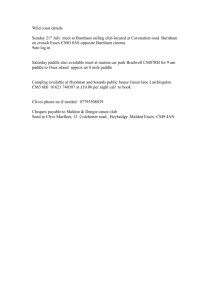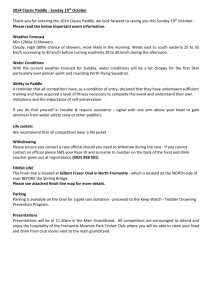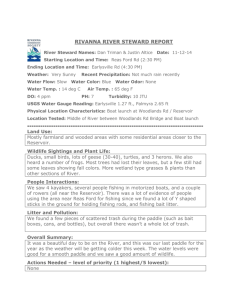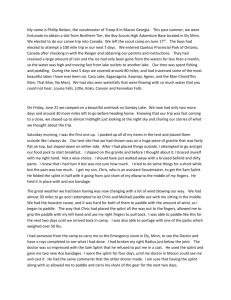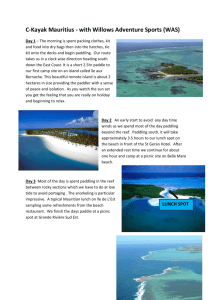File
advertisement
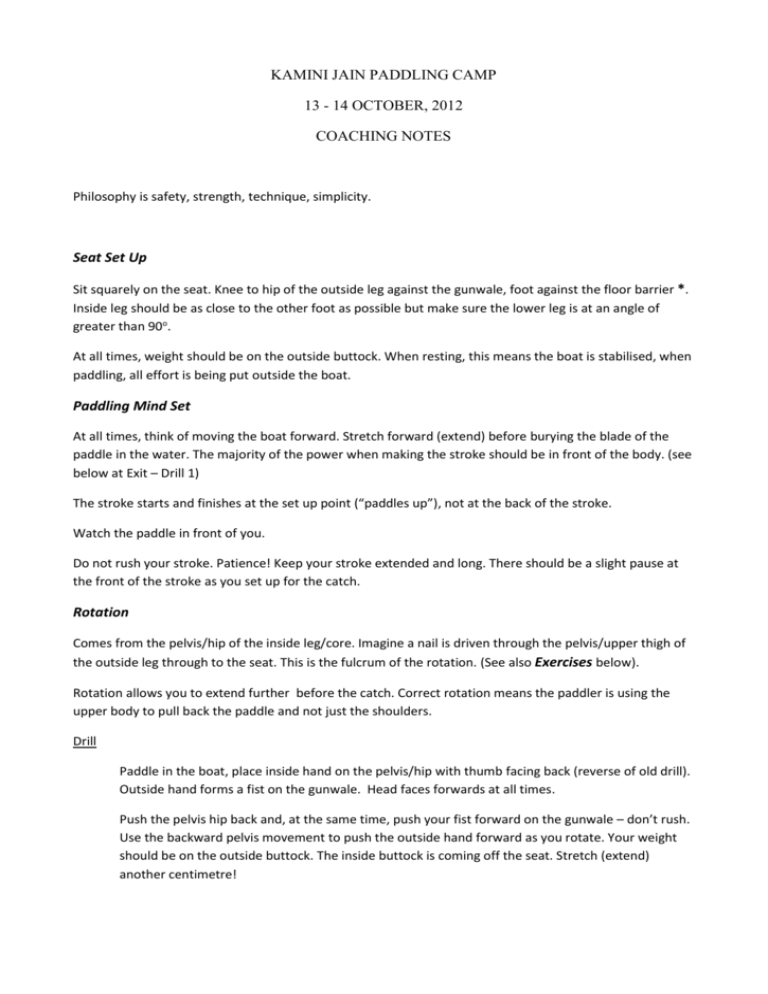
KAMINI JAIN PADDLING CAMP 13 - 14 OCTOBER, 2012 COACHING NOTES Philosophy is safety, strength, technique, simplicity. Seat Set Up Sit squarely on the seat. Knee to hip of the outside leg against the gunwale, foot against the floor barrier *. Inside leg should be as close to the other foot as possible but make sure the lower leg is at an angle of greater than 90o. At all times, weight should be on the outside buttock. When resting, this means the boat is stabilised, when paddling, all effort is being put outside the boat. Paddling Mind Set At all times, think of moving the boat forward. Stretch forward (extend) before burying the blade of the paddle in the water. The majority of the power when making the stroke should be in front of the body. (see below at Exit – Drill 1) The stroke starts and finishes at the set up point (“paddles up”), not at the back of the stroke. Watch the paddle in front of you. Do not rush your stroke. Patience! Keep your stroke extended and long. There should be a slight pause at the front of the stroke as you set up for the catch. Rotation Comes from the pelvis/hip of the inside leg/core. Imagine a nail is driven through the pelvis/upper thigh of the outside leg through to the seat. This is the fulcrum of the rotation. (See also Exercises below). Rotation allows you to extend further before the catch. Correct rotation means the paddler is using the upper body to pull back the paddle and not just the shoulders. Drill Paddle in the boat, place inside hand on the pelvis/hip with thumb facing back (reverse of old drill). Outside hand forms a fist on the gunwale. Head faces forwards at all times. Push the pelvis hip back and, at the same time, push your fist forward on the gunwale – don’t rush. Use the backward pelvis movement to push the outside hand forward as you rotate. Your weight should be on the outside buttock. The inside buttock is coming off the seat. Stretch (extend) another centimetre! Push the pelvis/hip forward as your outside hand comes back quickly and with feeling! You should be using the pelvis/hip to pull back as your upper body rotates back to where it started. Extension We are trying to move the stroke forward i.e. extending forward as far as possible and getting the paddle out quickly to return to the set up position. We know we’re doing this correctly if the boat is moving forward at all times rather than going forward, for example, 2 metres and back ½ metre with each stroke. Drill for Lower Arm Imagine you’re at a buffet dinner and you see someone across the table you haven’t seen for ages. You stretch across the table to shake their hand. They’re a little too far away so you stretch further. Then you see your sleeve is falling into the gravy so you must lift your arm up slightly. Purpose – the lower arm is straight and above and parallel with the boat ready to drop the arm triangle by lowering at the pelvis hinge (see below under Catch). There is full extension. The chest should be opened up with tension across the upper body. Be sure to extend the whole paddle not just the blade. Keep the upper arm away from the body. Don’t tip the top part of the paddle towards your head. (Tip:- imagine the bungee is tied to the middle of the paddle shaft. The pressure of the bungee’s elasticised rope is pulling the whole paddle forward) Drill for Upper Arm Paddles up. Extend. Touch your forehead with the top of the paddle. Push it away. The aim is to make the paddler conscious of where the top hand is and think about keeping the top arm away from the body. Catch etc Catch Imagine the body as an inverted triangle shoulder to shoulder and down to the pelvis. Imagine your arms (in the set position) as another triangle (although the top arm will be slightly bent). Once the paddler is fully extended, the arm triangle stays in position and the body moves towards the water as the upper body drops down from the pelvis/hips. From the side, the paddle will be at about a 45o angle but, at the catch and as the body is pushed down towards the water, the blade is almost going straight in. Drill Paddles up. Check rotation. Weight on the outside buttock. Chest open. Bottom arm straight and parallel with the water. Top arm (almost) straight. Bend from the outside hip/pelvis trying to keep your lower paddle arm straight. Make sure the blade is buried before pulling back. Power for the Catch – Top Arm/Hand Top hand/arm should drive the paddle into the water. The blade should be into the water and in position before pulling back. Drills 1. Put wrist of inside hand on top of the paddle (pull back glove). Do a few strokes practising pushing the paddle down into the water with the top hand. If the paddle wobbles, it indicates the blade is not fully in the water before pulling back (and/or the paddle shaft is not perpendicular to the water). Without stopping, paddle again with the top hand in its paddling position. 2. Tahitian grip – grip the top of the paddle shaft with inside hand. Drive blade into the water as above. Exit We want to get the paddle out of the water as quickly as possible to return to the start of the stroke and set up. The paddle should come out of the water somewhere between the knee and hip but definitely not go past the hip. The blade will be at a slight angle (“negative”) i.e. the tip may be just past the hip but the paddle shaft and top will be out at, or before, the hip. The tendency, which we are trying to avoid) is to use the ‘choo-choo’ effect i.e. bending the elbow and raising the paddle straight out. This puts more pressure on the shoulders and is less efficient. Drills 1. Push/pull. The ideal is for each paddler to be able to feel when the pressure of water goes off the blade – that’s the time to get the paddle out of the water. Push the paddle forward (still in the water), pull the paddle back (still in the water) and exit. The call is “Push, pull”. The paddler determines when to get the paddle out but the exit action is quick. As you go back to the start (and finish) of the stroke, imagine you are lifting the lid of a box ready to look inside. 2. Batter stirring – start with the paddle buried in the water about half way between the knee and the hip of the outside leg. Pull the paddle back then ‘stir’ the batter as you slightly lift the upper arm, elbow and hand in one smooth action. 3. Whiffy armpits – imagine you have sweaty armpits and you want to get the breeze to dry them. Your upper arm, elbow and hand raise in one smooth movement as you get the paddle out of the water. Be sure, though, not to drop the top hand inside the boat. (Tip:- the bottom hand should never go behind the outside shoulder. If it does, it indicates that the paddler is not rotating enough and/or the exit is too far back and/or the top of the handle is being pushed too far forward.) Exercises 1. Land-based exercise to free up the hips and assist with rotation Sit on the floor/ground with legs in front and slightly bent with the heels resting on the floor. ‘Walk’ on your bottom towards a target then ‘walk’ back. You use your hips and bottom to do the walking. 2. Shoulder strengthening and flexibility – “Yay, we won” - on the boat or on the land Paddle in both hands, raise the arms above your head making sure the arms are in line with the ears. Bend forward from the hips/pelvis making sure the arms stay aligned with the ears. Hold for a few seconds. Lower the arms to rest on the gunwale. Lift back towards the ears and sit up quickly, at the same time yelling, “yay, we won !” * If you cannot reach the floor barriers comfortably, place your outside foot where it is comfortable, then place the inside foot next to it so that the toes of the outside foot are locked into the instep of the inside foot.
